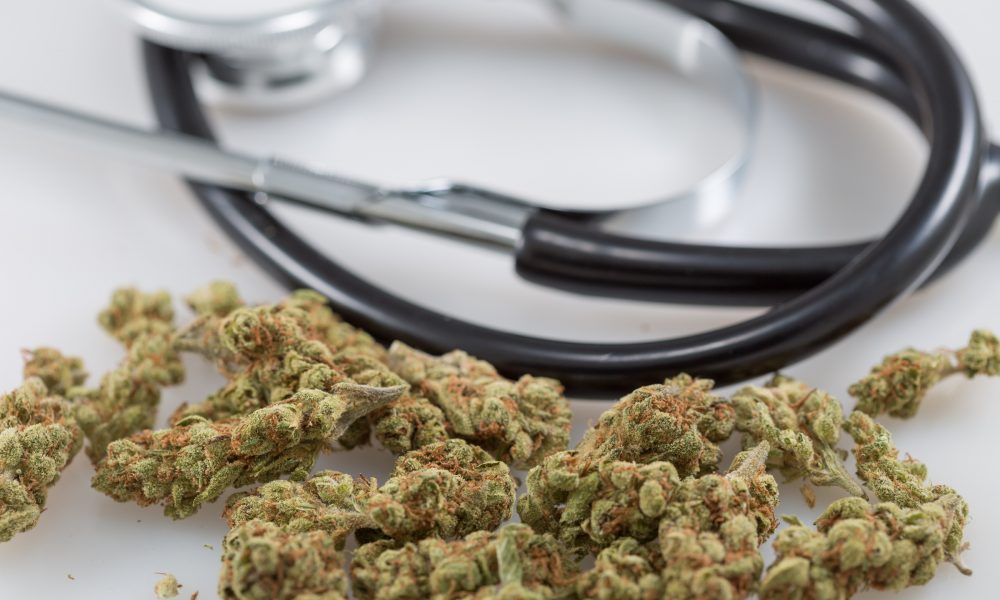“We’re performing community service at this point, at least in theory,. We might as well be a nonprofit.”
By David Abbott, Arizona Mirror
Arizona’s commercial marijuana market has gone through a seismic shift since 2021 began. Adult-use and recreational sales have overtaken medical marijuana, as cardholders abandon certifications and established businesses wrestle with the need to change with the times.
Throughout 2022, the Arizona Mirror has tracked a 7-month downward trend in medical marijuana sales, while the recreational market continues to set records.
The medical marijuana certification business has had to deal with economic and legislative dynamics beyond its control, leaving dispensary owners seeking ways to strengthen the flagging sector.
During its heyday in the years after voters passed the Arizona Medical Marijuana Act in 2010, the number of “qualifying patients” in the state reached more than 295,000 by the end of 2020.
Since that time, the number of people applying for new medical marijuana cards or renewing previously issued cards has fallen nearly by half: In its latest monthly report, the Arizona Department of Health Services shows just 158,154 active cards.
“We’re performing community service at this point, at least in theory,” Sun Valley Health co-founder and CEO Dustin Klein said. “We might as well be a nonprofit.”
What happened?
Between 2012, when ADHS authorized the first dispensaries and patients were legally able to purchase medical marijuana, and 2019, the Arizona medical marijuana market blossomed and grew quickly. Patients were required to renew certifications for $75 to $150 annually, and doctors charged additional fees, generally in the same price range.
The first Arizona effort to legalize recreational marijuana, 2016’s Proposition 205, was narrowly defeated at the polls, leaving the market stable. But voters in 2020 overwhelmingly approved Proposition 207, the Smart and Safe Arizona Act, making Arizona one of 15 states, two territories and Washington, D.C. to legalize marijuana for recreational use. (Adult-use, recreational is now legal in 18 states and the District of Columbia and medical marijuana is legal in 36 states.)
The seeds of the decline of the medical marijuana program began in June 2019, when Gov. Doug Ducey (R) signed Senate Bill 1494 into law. Among other things, SB1494 was intended to streamline the certification process by creating an electronic card system and lowering patient costs by extending the life of a card to two years.
In 2020, the COVID-19 pandemic shut-down led to record sales—Arizonans purchased nearly 106 tons of various forms of medicinal cannabis, a significant increase from 2019, which weighed in at almost 83 tons—and a boon for the retail end of the business.
But COVID-19 proved to be both a blessing and a curse to the cannabis business. On the positive side, for several months during the shutdown, sales spiked in the waning days before recreational sales began. But the pandemic also kept many winter residents away, leading to an additional loss of revenue for the certification businesses serving transient populations.
Recreational sales began on January 28, 2021. Though recreational sales didn’t immediately overtake the established medical market, they had done so by December—and they haven’t looked back since.
Effects on the certification business
Over the course of 100 days, everything changed for Sun Valley Health.
While some have been able to weather the storm, Sun Valley Health has struggled. The company at its height had eight locations in three states—Arizona, Nevada and Florida — had 66 employees, including 22 doctors, and a $2.2 million annual payroll.
At one point, according to Klein, Sun Valley certified 30,000 medical marijuana patients in Arizona—nearly one in every four who got a medical marijuana card—per year at its five locations.
It all came crashing down for Sun Valley. The company is down to just a single Arizona location. On the worst day, Klein said he had to lay off 43 employees, some of whom had been with the business for more than five years.
He said there has been a 30-50 percent drop in revenues for certification businesses since 2020.
In an attempt to revitalize the business, Sun Valley has added new services such as ketamine therapy, as well as other alternative therapies such as naturopathy and chiropractic.
Not all certification centers have suffered as badly as Sun Valley, though.
Taryn Tia, the Arizona operation manager for Dr. Reeferalz, said the company was seeing 25 to 40 new or returning patients a day at each of its five clinics at the height of the medical marijuana market. That number dropped to about 15.
Dr. Reeferalz now has four clinics, three in the Phoenix area and one in Tucson.
“We probably saw a 35 percent to 45 percent decrease in business between the start of two-year cards and the start of recreational sales,” she said. “But we’ve seen an increase in 2022 since that dip.”
The increase has come from a concerted effort to reach out to renewal patients and partnering with dispensaries and pain clinics for referrals.
There has also been an increase in certifications for 18 to 21 year olds, since adult-use is only legal for those over the age of 21. She also believes the novelty of legal purchases has worn off.
“A lot of our patients were discouraged by long waits [at retail outlets], low-dosage products and high taxes,” Tia said.
But one of the most important aspects to reviving the certification business for Dr. Reeferalz is educating patients on the benefits of possessing a medical card.
Benefits of the medical program
Cardholders in the medical marijuana program enjoy many benefits not available to recreational users. They pay lower taxes on cannabis, can possess more marijuana, have legal protections in housing and employment, can grow more cannabis at home and have legal access to at-home delivery.
Medical patients can possess up to 2.5 ounces of cannabis “flower,” while recreational users are limited to one ounce and five grams of concentrates or extracts. Edible products, such as gummies, are limited to 10mg THC per serving and 100mg packages for recreational, but medical patients can purchase products with much higher THC dosages.
Medical marijuana patients can grow up to 12 plants, but without a card, persons 21 years of age and older can grow six plants per adult in an individual’s primary residence.
One of the biggest draws to maintaining a medical card, though, is savings on commercially available marijuana.
Medicinal products have a state sales tax rate of 6.6 percent, with an additional 2 percent to 3 percent local tax, depending on the jurisdiction. Recreational sales are charged a 16 percent excise tax plus the TPT and local taxes, meaning the average recreational cannabis user can pay up to 25 percent in taxes.
According to Klein, medical patients spend 30-50 percent more than recreational customers. Medical patients average $3,500 a year, while recreational customers spend an average of about $2,000.
“The savings is unbelievable: If a patient spends $77 a month, the card pays for itself,” he said.
Dr. Reeferalz has a calculator on its website that estimates how much medical patients can save over recreational costs, given the higher taxes paid by the latter.
“It helps being able to understand if it’s worth it,” Tia said. “If you’re not spending that much a week, you don’t need delivery, you don’t care about any of that, then it makes sense to buy recreational.”
Card holders cite costs, inconvenience as reasons for leaving the program
While there are likely many reasons for patients to leave the program, the cost of certifications and the added inconvenience of the process have been cited.
Green Valley resident and former medical cardholder Greg Knowles first got a card in December 2018, but recently let it expire because he does not purchase enough to make it worth his while.
He “got his calculator out” and decided he would have to buy at least $1,000 of marijuana a year in order to justify keeping his card.
“I probably spent a total of $300, not more than $350 that entire first year,” he said. “It cost me $150 to spend that amount of money. I did renew the second year and got to checking and thought, ‘What am I doing here?’”
Knowles, who received his card for chronic pain, learned a lot about the program from the employees at Hana Dispensary and settled on low-dosage gummies. He appreciated having his card when recreational became legal because of the initial lines and wait times for service, but says now that “the shine has worn off” of legal sales, he doesn’t have to invest so much time anymore.
“People are finding the same thing that I found out, that it’s an absolute rip-off,” he said. “I can go in there as a private citizen, buy what I need, pay the 24 percent, but I’m never going to reach that threshold to break even.”
Inconvenience can be another reason people are walking away from the program, or at least delaying renewal.
Arizona NORML acting Executive Director Jon Udell said he has procrastinated getting his medical certification renewed because of the time involved and the easy availability of recreational cannabis.
“I have strong support for the medical marijuana program,” he said. “But for me, there’s no certification centers close by: The closest one is like 45 [minutes] to an hour-long round trip. That’s a significant chunk of my day.”
As to the long-term costs, Udell says it is easier to think more immediately, even if over time recreational purchases end up costing more, but it is in the patient’s best economic interest to remain in the program.
“Human nature is that we value immediate costs more than we value distant costs,” he said. “If I spend $80 at the dispensary, I pay $12 in taxes—$12 is a lot less than $300, so I’m gonna pay less money, right? Then we discount the fact that, every single month, we’ll be paying $12 or more than. I’m guilty of that as well.”
Changes in the market lead to changes in thinking
Ryan Hermansky, founder of Flagstaff’s Noble Herb dispensary, PURE Edibles and president of the Arizona Dispensary Association has seen many sides of the economic dynamics play out over his nine years in the industry. Dispensary owners, he said, are aware of the need to maintain a strong medical market.
Hermansky, his brother Brandon and partner Doug Daly, opened in June 2013 as Greenhouse of Flagstaff and is one of the remaining original licensees in the state.
“We’re very aware of these declining numbers happening, I think, far faster than anybody expected,” he said. “Now there’s going to be a big focus on what we can do to strengthen the program and keep it strong in Arizona. We’re all founded off of a strong medical program and I think as we move forward as a marijuana state, it’s important to have a strong medical program as well as a strong adult use program.”
Despite his belief in the medical program, Hermansky’s PURE edibles has begun to tailor its products to the recreational market by focusing on low-dose gummies, as are other edible producers in the state.
The company intends to roll out a new product in the fourth quarter of 2022 that will be 10mg in 100mg packages, the maximums allowed for recreational sales.
He says that higher-dosage products have become something of a niche market, but he is convinced the need for medical-grade products will always be there.
“We’re making some slight changes [because] we’re seeing it not only on our retail side, as far as people coming in our store, but it’s also what’s being purchased [from] PURE throughout the state,” he said. “We’re absolutely seeing it and making some adjustments to our product portfolio moving forward.”
Hermansky added that the Arizona Dispensary Association is strategizing and reaching out to potential partners, including AZNORML, to find a way to revitalize the sector.
“I don’t think the medical program will go away and we’re going to do everything we can to not only keep it, but strengthen it,” he said. “There’s certainly some goals in line with [AZNORML] on trying to strengthen the program and get numbers back up.”
Udell says it is in dispensary owners’ best interests to shore up the medical program and welcomes conversations that can accommodate more consumer-friendly laws and ultimately lower prices for patients and recreational users alike.
“This is a very big concern of many people who are either industry adjacent, or CEOs of dispensaries,” he said. “It’s in their own economic self-interest to expand the medical program, and there’s been a variety of interesting conversations that have been happening.”
This story was first published by Arizona Mirror.
Medical Disclaimer:
The information provided in these blog posts is intended for general informational and educational purposes only. It is not a substitute for professional medical advice, diagnosis, or treatment. Always seek the advice of your physician or other qualified healthcare provider with any questions you may have regarding a medical condition. The use of any information provided in these blog posts is solely at your own risk. The authors and the website do not recommend or endorse any specific products, treatments, or procedures mentioned. Reliance on any information in these blog posts is solely at your own discretion.







